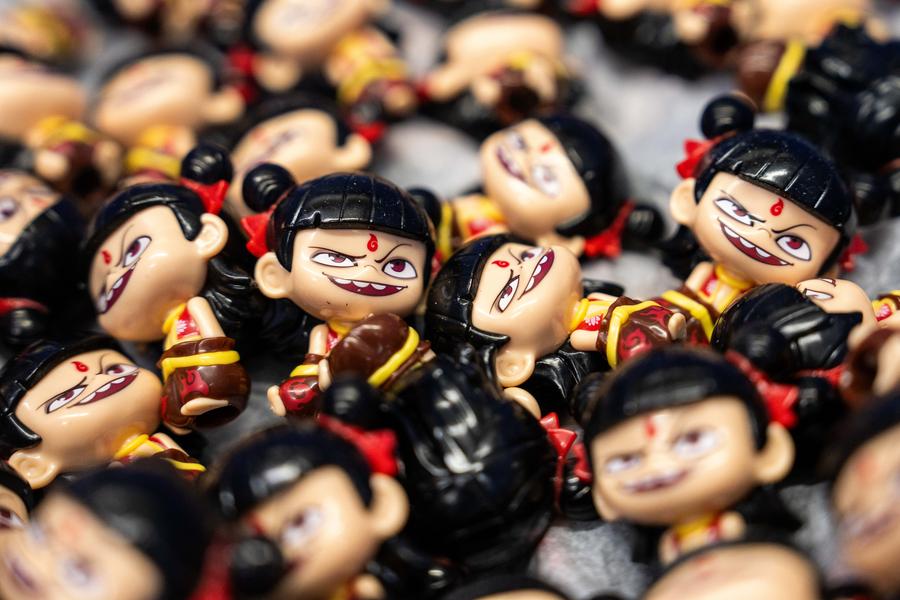
Toys featuring Ne Zha, the main character from "Ne Zha 2", are pictured at a toy manufacturer's workshop in Xiangtan, Central China's Hunan province, on Feb 8, 2025. [Photo/Xinhua]
GUANGZHOU -- In the bustling production workshop of a cultural products company in South China's Guangdong province, miniature figurines of Ne Zha, Ao Bing and Tai Yi -- all from the Chinese animated blockbuster "Ne Zha 2" -- are rolling off the assembly line at full speed.
As demand skyrockets, company president Sun Wenke finds his phone ringing off the hook. In addition to updates on mold production, inquiries from distributors, and collaboration requests from eager brands are flooding in.
The driving force behind this frenzy is the phenomenal success of the film, which has shattered multiple box office records around the globe. The film's popularity has triggered a buying spree for themed figurines, keychains, and badges.
Many products have sold out both online and offline, with resale prices soaring several times higher than before. Fans have jokingly remarked that after scrambling to secure cinema tickets, they now find themselves fighting for collectibles.
Many of these sold-out products are made in Dongguan, known as China's "capital of designer toys." Established toy manufacturers such as Sun's WoFactory are turning the film's characters into highly sought-after real-world collectibles through innovative designs and craftsmanship.
Founded in 2017, WoFactory is a cultural and creative company specializing in design, research, and production, having supported over 2,000 designer brands.
"Our initial order before the film's release was 10,000 sets. Just days ago, an additional order was placed, multiplying demand by several hundred times, with total orders exceeding 100 million yuan ($13.95 million)," Sun said.
The unprecedented surge in orders has left companies both excited and feeling the pressure.
"We have accelerated mold production to shorten the manufacturing cycle. Typically, it takes 35 to 60 days to produce a mold and another 45 to 90 days to complete a product, but now we can deliver the products to consumers in just over 20 days," Sun said.
To cope with the overwhelming demand, WoFactory has leveraged Dongguan's industrial ecosystem. After securing the massive order, the company partnered with dozens of local toy manufacturers to maximize production capacity and fulfill orders efficiently.
Meanwhile, at Guangdong Henglitai Craft Products Co Ltd, production lines are running 24/7 to meet demand.
"We are working around the clock to manufacture Ne Zha merchandise," said Cheng Shuiqiao, the company's engineering manager.
Henglitai's first batch of 300,000 Ne Zha-themed acrylic posters, transparent cards, badges, and filmstrip - nicknamed "life must-haves" by fans — sold out instantly before the Chinese New Year. The company has since received orders ten times that size.
Dongguan has in recent years become a global hub for designer toys, producing a quarter of the world's anime-related merchandise and 85 percent of China's designer toy products.
The city's well-established industrial chain and supply network have given companies a competitive edge. In Shipai town, where WoFactory is based, within a 5-kilometer radius, a fully integrated ecosystem covers everything from design and mold manufacturing to assembly and logistics — all accessible within a 15-minute drive.
"We are building an AI-powered prototyping center to integrate AI into toy manufacturing," said Liu Xueyi, deputy director of the economic development bureau of Shipai. "This will boost production efficiency by 20 percent and cut the average manufacturing time by 20 days."
Beyond manufacturing, brand partners have also been blown away by the meticulous attention to detail shown in various products.
"For Ne Zha-themed merchandise, we introduced subtle design touches such as adding a glitter effect to color cards to replicate the film's fiery visuals, and applying iridescent film to acrylic keychains to create shifting colors depending on the angle," said Cheng.
The rise of China's designer toy industry is also a reflection of growing cultural confidence.
"Two years ago, only 40 percent of our products were based on Chinese intellectual properties (IPs), while the majority came from foreign franchises. Now, that trend has seen a complete reversal -- Chinese IPs dominate our production line," Cheng said. "It's a sign of our cultural soft power strengthening on the global stage."